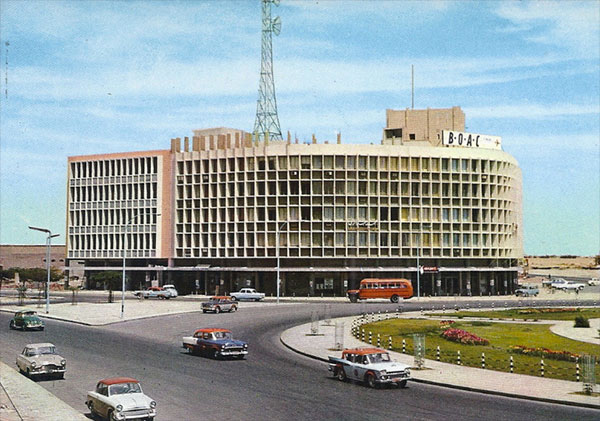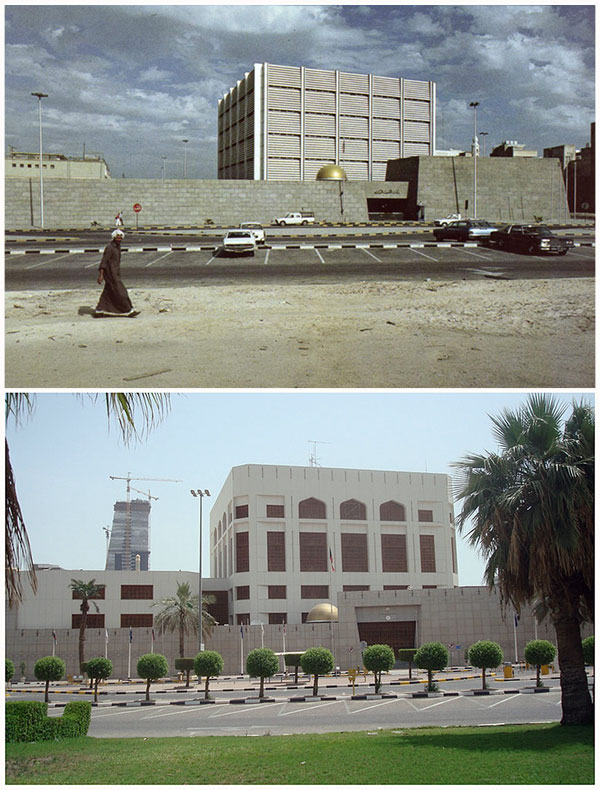
AGI Architects recently published an interesting article called on the modern architecture of Kuwait in the 70s. If you have any interest in architecture you should check it out [Here]
From the same article, I also found a link to a Danish architecture photographer who had some interesting insight into the original Central Bank of Kuwait building (which I’ve posted about before). This is what he had to say about it as well as about the refurbishment:

Bharani sent me a link describing the fate of modern architecture in kuwait, including jacobsen’s late project for the kuwaiti national bank, built after his death by business partners dissing & weitling. I thought I’d share it with you.
the house in its original state bears a resemblance to the national bank in copenhagen, but with important differences: the fort-like cube above the base with its hidden courtyard, the dome in front of it, the sun screen facade, the slanted walls of the base, suggesting mud-brick construction, all have more or less local precedents.
not all equally subtle – the gold dome may well hurt your eyes – they nevertheless point to the possibility of a kuwaiti modernism which would not simply be a copy of western architecture.
that a local version of 20th century architecure arrived by way of copenhagen may cause some to reach for their copy of edward said’s ‘orientalism’, but I believe they would be wrong. since le corbusier’s love affair with arab architecture, it has been part of the DNA of modernism and has often been met with the admiration and study afforded a true role model.
the central bank has changed, should you be in doubt. its current state shows a make-over in a style I like to call hotel lobby exotic, and which not only renders any building instantly provincial, but also shows a trend I have been following for a while and from a distance, that of self-orientalism in architecture.
I lack the necessary masochism to appreciate eward said’s slut-shaming of the entire west except as a polemical stance, but here’s a useful concept: self-orientalism is most obvious in the staged sights of mass tourism, in which western stereotypes from the days of colonialism are applied or should we say self-inflicted for profit.
on a smaller scale your local ethnic eatery could be pandering to stereotype, we all know examples of that, but the real interest always lies at the level of architecture where we are invariably talking politics.
lately, we have seen new mosques in copenhagen in a similar style – two parts budgetary cynicism to one part fairground attraction. few have commented on their inadequacies – with the cartoon crisis still in fresh memory, nobody wants to draw the attention of the muslim right or of the Danish nationalists for that matter.
what the mosques show only too well is how poorly we are answering the question of what it means to be a Danish muslim as opposed to just being a muslim in denmark. or how poorly the 200.000 people struggling with this question daily are represented by their own institutions.
it is no accident. islamic institutions are financed from abroad by conservatives to whom integration itself is a threat. when Danes fear that muslims will forever be strangers in the land, this fear is willfully confirmed by silly orientalist ornament, designed to be misread.
yet, it strikes me as obvious how well architecture could provide a dignified answer. the lessons of islamic architecture are already found in the legacy left us by jacobsen, utzon and spreckelsen. the stern repetitions of the great persian brick monuments are mirrored perfectly in many of kay fisker’s buildings.
how easily we could build democratic institutions that would be right at home in copenhagen, yet feel like home even to a newcomer. how easily we could set in stone the values that unite us. only the state could pay for such a thing, but it would finally release Danish muslims from the subjection to foreign interests.
the muslim world cannot be expected to do it, split as it is along any number of lines you can think of, be it national, ethnic, shia/sunni, moderate/fanatical, educated or not, grotesquely rich or grotesquely poor. it is a house divided against itself, as the expression so tellingly goes, offering us the architectural equivalent of a fast food vendor dressed in a fez.
If you want to check out more pictures of the Central Bank when it was originally constructed, click [Here]

One reply on “Power and the City. Modern Architecture of the 70s in Kuwait and Madrid”
I am a bit sad that no one commented on this, as it is an interesting take on Kuwaiti architecture, explaining a lot why Kuwait looks the way it looks. My parents were both architects working at the local Kuwait engineering company, INCO, and they would spend evenings ranting at clients, who would make unauthorised changes to projects. A particularly memorable one was when my mum, after spending the best part of two years getting the marble columns at the ministry of interior just right returned to see them covered in cheap mosaic. If anyone feels like reading up their story, it can be found here: https://www.ingentaconnect.com/content/intellect/ijia/2015/00000004/00000002/art00006?crawler=true